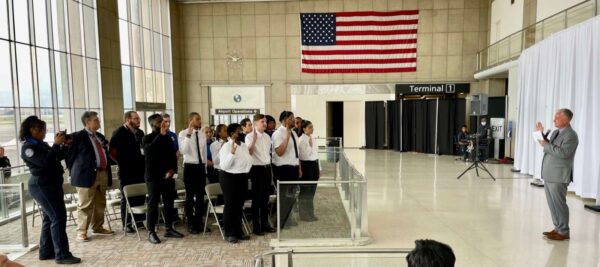TSA officials commemorate 20th anniversary of the federalization of Ronald Reagan Washington National Airport
Officials from the Transportation Security Administration (TSA) commemorated the 20th anniversary of the federalization of Ronald Reagan Washington National Airport (DCA) today by recognizing members of the workforce who have been with TSA for 20 years, swearing in new TSA officers and looking back at the earliest days of TSA and two decades of evolution.
The airport launched under TSA security oversight 20 years ago, on Sept. 17, 2002, when the security checkpoint was first staffed by federal TSA officers one year after the terrorist attacks of Sept. 11, 2001.
The Aviation and Transportation Security Act (ATSA) became law in November 2001, formally establishing the TSA. That fall, TSA consisted of about 100 people working at folding tables in the basement of Department of Transportation national office. Today, 20 years later, there are 430 federalized airports and a workforce of about 60,000 employees nationwide. TSA has a staff of approximately 700 employees who are assigned to work at DCA of which nearly 50 of them have been working for TSA since the agency first stood up and since the airport was federalized.
“The days and weeks that followed 9/11 were filled with chaos, anxiety and a host of unknowns for the way forward,” said John Busch, TSA’s Federal Security Director for DCA. “The attacks on that day forever changed us, both as a nation and as individuals. As we pledge to never forget, we recall those who died that day and show our respect to their loved ones who still miss them 21 years later,” he said.
“Much has changed and evolved over the past 21 years, yet I am proud to note that one thing has not changed,” Busch continued. “It is our collective commitment to ensuring the security of our nation. It is a difficult mission that we have, one which requires all of us to cooperate and collaborate towards a common goal–that every traveler who departs from, arrives at or transits through DCA does so with the confidence that they will end their day safe and secure, no matter their destination.”
In the intervening years since launching, TSA has developed and implemented strong security procedures, built a well-trained and highly skilled professional workforce, and introduced a wide array of state-of-the-art technologies to screen passengers, baggage and cargo.
“As we recognize 20 years of federal screening at DCA, and perhaps ponder what a screening checkpoint may look like in 20 years, we must remain cognizant of how we got here,” said Ron Mildiner, TSA’s Deputy Federal Security Director for DCA. “We arrived here by relying on the judgement and integrity of hundreds of officers every single day, upholding an oath to the Constitution to ensure secure travel for the flying public.”
Guided by an intelligence-based approach, today TSA is at the forefront of security technology and innovation. Technologies such as computed tomography, credential authentication technology and advanced imaging technology have greatly improved TSA’s detection and identity verification capabilities in ways the initial group of TSA employees could have only imagined 20 years ago.
Much has changed since TSA was first established, however some things have not. “What remains the same are the people of TSA,” said Paul Malandrino, Metropolitan Washington Airports Authority’s DCA Airport Manager who became TSA’s first federal security director in 2002 when he was appointed to the position at Baltimore Washington Thurgood Marshall Airport. “Their dedication, professionalism and commitment to ensuring the safety and security of our passengers is as strong today as it was 20 years ago. It’s gratifying to see how this very important mission – aided by amazing advances in technology and the continuing dedication of such a capable and talented team – is still moving forward.”
“With the promise of more effective and rapid computed tomography machines on the horizon, I expect the appearance and makeup of our checkpoints will continue to evolve, such that 20 years from now, we will hardly be able to recognize them,” Mildiner noted.


